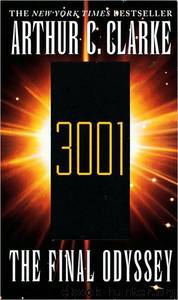3001 by Arthur C. Clarke

Author:Arthur C. Clarke
Language: eng
Format: mobi, epub
Tags: Speculative Fiction
ISBN: 9780613132053
Publisher: Turtleback Books: A Division of Sanval
Published: 1996-01-01T00:00:00+00:00
SOURCES
Chapter 1: The Kuiper Belt
For a description of Captain Chandler's hunting ground, discovered as recently as 1992, see 'The
Kuiper Belt' by Jane X. Luu and David C. Jewitt (Scientific American, May 1996)
Chapter 3: Rehabilitation
I believed that I had invented the palm-to-palm transfer of information, so it was mortifying to
discover that Nicholas ("Being Digital") Negroponte (Hodder and Stoughton, 1995) and his MIT Media Lab
have been working on the idea for years. .
Chapter 4: Star City
The concept of a 'ring around the world' in the geostationary orbit (CEO), linked to the Earth by towers
at the Equator, may seem utterly fantastic but in fact has a firm scientific basis. It is an obvious extension
of the 'space elevator' invented by the St Petersburg engineer Yuri Artsutanov, whom I had the pleasure
of meeting in 1982, when his city had a different name.
Yuri pointed out that it was theoretical y possible to lay a cable between the Earth and a satel ite
hovering over the same spot on the Equator which it does when placed in the CEO, home of most of
today's communications satel ites. From this beginning, a space elevator (or in Yuri's picturesque phrase,
'cosmic funicular') could be established, and payloads could be carried up to the CEO purely by electrical
energy. Rocket propulsion would be needed only for the remainder of the journey.
In addition to avoiding the danger, noise and environmental hazards of rocketry, the space elevator
would make possible quite astonishing reductions in the cost of al space missions. Electricity is cheap,
and it would require only about a hundred dol ars' worth to take one person to orbit. And the round trip
would cost about ten dol ars, as most of the energy would be recovered on the downward journey! (Of
course, catering and inflight movies would put up the price of the ticket. Would you believe a thousand
dol ars to CEO and back?)
The theory is impeccable: but does any material exist with sufficient tensile strength to hang al the
way down to the Equator from an altitude of 36,000 kilometres, with enough margin left over to raise
useful payloads? When Yuri wrote his paper, only one substance met these rather stringent specifications -
crystal ine carbon, better known as diamond. Unfortunately, the necessary megaton quantities are not
readily available on the open market, though in "2061: Odyssey Three" I gave reasons for thinking that
they might exist at the core of Jupiter. In "The Fountains of Paradise" I suggested a more accessible
source - orbiting factories where diamonds might be grown under zero-gravity conditions.
The first 'smal step' towards the space elevator was attempted in August 1992 on the Shuttle Atlantis,
when one experiment involved the release - and retrieval - of a payload on a 21-kilometre-long tether. Unfortunately the playing-out mechanism jammed after only a few hundred metres.
I was very flattered when the Atlantis crew produced The Fountains of Paradise during their orbital
press conference, and Mission Specialist Jeffrey Hoffman sent me the autographed copy on their return to
Earth.
The second tether experiment, in February 1996, was slightly more successful: the payload was indeed
deployed to its
Download
This site does not store any files on its server. We only index and link to content provided by other sites. Please contact the content providers to delete copyright contents if any and email us, we'll remove relevant links or contents immediately.
Sita - Warrior of Mithila (Book 2 of the Ram Chandra Series) by Amish(54652)
The Crystal Crypt by Dick Philip K(36771)
Cat's cradle by Kurt Vonnegut(15184)
Always and Forever, Lara Jean by Jenny Han(14799)
Ready Player One by Cline Ernest(14524)
The Last by Hanna Jameson(10146)
Year One by Nora Roberts(9700)
Persepolis Rising by James S. A. Corey(9225)
The remains of the day by Kazuo Ishiguro(8821)
Never let me go by Kazuo Ishiguro(8710)
Red Rising by Pierce Brown(8608)
Dark Space: The Second Trilogy (Books 4-6) (Dark Space Trilogies Book 2) by Jasper T. Scott(8116)
The handmaid's tale by Margaret Atwood(7679)
The Circle by Dave Eggers(7035)
Frank Herbert's Dune Saga Collection: Books 1 - 6 by Frank Herbert(6938)
The Testaments by Margaret Atwood(6773)
Legacy by Ellery Kane(6583)
Pandemic (The Extinction Files Book 1) by A.G. Riddle(6458)
Six Wakes by Mur Lafferty(6151)
